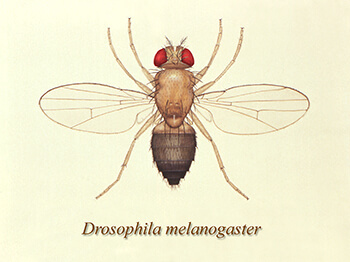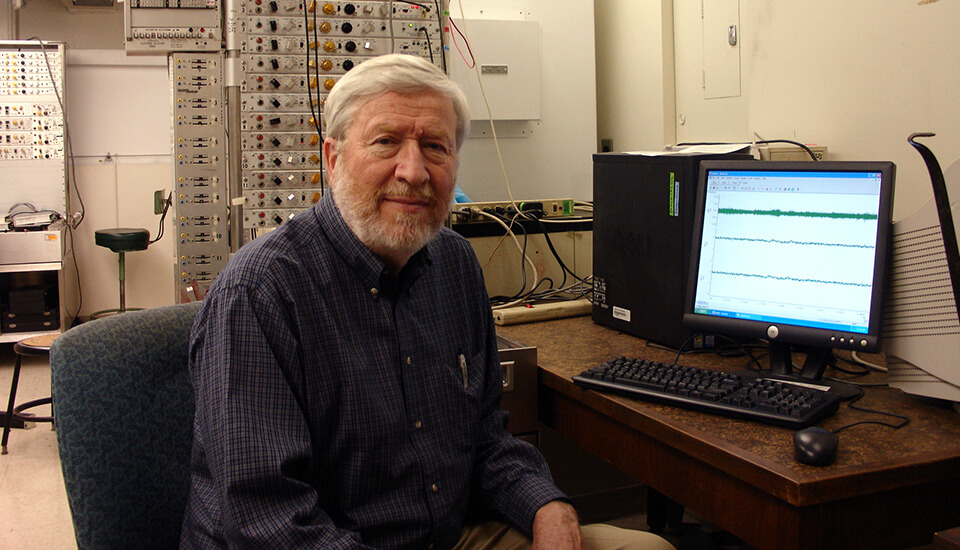 Rocky, Dean Hendricks’ English Bulldog, snoozes at her feet. This breed was the subject of Hendricks’ sleep apnea research.
Rocky, Dean Hendricks’ English Bulldog, snoozes at her feet. This breed was the subject of Hendricks’ sleep apnea research.
Scientists knew a lot about fruit flies by the late 1990s. But they didn’t know that flies slept.
That insight entered the scientific literature in the year 2000, thanks to Penn Vet Dean Joan Hendricks, then
a professor in the Department of Clinical Studies – Philadelphia. She was spending a sabbatical year learning molecular biology techniques in the laboratory of Dr. Amita Sehgal of the Perelman School of Medicine. In doing so, she discovered that, while fruit flies’ rest periods couldn’t be measured by an electroencephalogram (EEG) test, the insects shared many similarities to what we think of as sleep.
 Now dozens of labs use fruit flies, or Drosophila, as a model for sleep, a fact that owes a debt to Hendricks.
Now dozens of labs use fruit flies, or Drosophila, as a model for sleep, a fact that owes a debt to Hendricks.
“There is so much power in studying sleep in fruit flies,” she said. “You can make such rapid progress when your ‘n’ is in the hundreds. You just can’t do that if your study subjects are dogs or people.”
Before she was Dean, Hendricks was an
expert on sleep and sleep disorders. And
though she hasn’t had a direct hand in
research since she stepped into her current
leadership role in 2006, her contributions
to the field, through work conducted in
Bulldogs and fruit flies, have endured.
“Her helping establish a Drosophila model
for sleep has been transformative in the sleep
field, and it’s taken off,” said Sehgal. “My
lab has continued to work with the fly sleep
model and gotten a lot of really good papers
from it. That early work has been very
fruitful indeed.”
When Hendricks was an undergraduate at
Yale University in the early 1970s, the term
“neuroscience” wasn’t yet widely used. But
Hendricks crafted a dual major in biology
and psychology to learn about the ways that
the brain controlled behavior.
“I was absolutely riveted by the idea that
interesting, complicated behaviors have
roots in measurable, tangible biology,” she
said.
Upon entering the dual VMD-PhD
program at Penn Vet, she joined the lab
of Dr. Adrian Morrison, now Professor
Emeritus, studying the fundamental
mechanisms of sleep.
 Penn Vet Professor Emeritus Dr. Adrian Morrison in his lab, surrounded by equipment used in his sleep research. Dean Hendricks joined Morrison’s lab during her VMD-PhD program.
Penn Vet Professor Emeritus Dr. Adrian Morrison in his lab, surrounded by equipment used in his sleep research. Dean Hendricks joined Morrison’s lab during her VMD-PhD program.
As she was finishing her degrees,
researchers in the sleep field started to
realize that a sleep disorder characterized by
frequent snoring, long pauses in breathing
while sleeping, and fatigue during waking
hours appeared to be much more common
than they first thought. Now sleep scientists
know that the disorder—sleep apnea—affects
more than half a million people around the
globe.
While there were recognized risk factors
for the condition, such as being male and
obese, researchers were only just beginning
to understand its root causes. And Hendricks
saw room to contribute.
“The question was, ‘What can I do as
a veterinarian, using my training and my
access to animals, to have an impact on this
mystery of sleep apnea?’” Hendricks recalled.
The question initially led her to a dog
breed well known for their flat faces and
breathing difficulties: English Bulldogs.
Hendricks quickly realized that this breed,
unlike others, had all the characteristics of
sleep apnea.
“Every Bulldog had this problem,”
Hendricks said. “They wouldn’t have apneas
during the first phase of sleep, but during
REM sleep, they would have pauses in
breathing that lasted up to 45 seconds or a
minute, and their oxygen saturation would
plummet.”
Teaming with clinicians in the medical
school, including Dr. Allan Pack and Dr.
Sigrid Veasey, Hendricks explored the
mechanical and neurological features of sleep
apnea in Bulldogs—insights that seemed
to make it an ideal model for translational
research.
“The recordings in the Bulldogs were
remarkably similar to what we see in
humans,” said Veasey.
Among other insights, Hendricks and
colleagues found that the Bulldogs fired the
motor neurons in their airways continuously.
This firing subsided when the dogs slept,
leading to the apnea episodes. Other
researchers later confirmed that humans with
sleep apnea do the same thing.
Hendricks and Veasey went on to target
the neurochemical pathways that trigger the
airway neurons, testing drug combinations
that could be used to keep the airway open
during sleep. They weren’t able to come up
with a combination that could selectively
target the airway neurons, but both see it as
a promising area of research.
It was around this time when Hendricks
took her sabbatical, joining Sehgal’s lab and
developing an interest in fruit flies. She
recalled long days spent watching flies drift
off and began developing criteria to define
sleep that didn’t rely on EEG recordings.
She noted that there were regular periods
when the flies were clearly resting; that they
had a reduced sensitivity to stimuli during
rest; and they “made up” for lost sleep if
deprived of it. In addition, she worked with
colleagues to probe such areas as circadian
rhythms, sleep-related gender differences,
and the connection between sleep and
immune system function.
Hendricks still speaks animatedly about
her pioneering work in sleep research, as
well as the discoveries yet to be made. “I’m
curious about the molecular changes that
occur with aging and how they affect sleep,
and the relationship between Alzheimer’s
and sleep,” she noted.
She’s glad to have highlighted how
studying multiple species—and contributing
her insight as a veterinarian—can be of value
in making scientific breakthroughs impacting
people and animals. It’s the concept of One
Health in action.
“We shouldn’t get boxed into studying
one kind of organism if we’re looking at a
problem,” she emphasized.